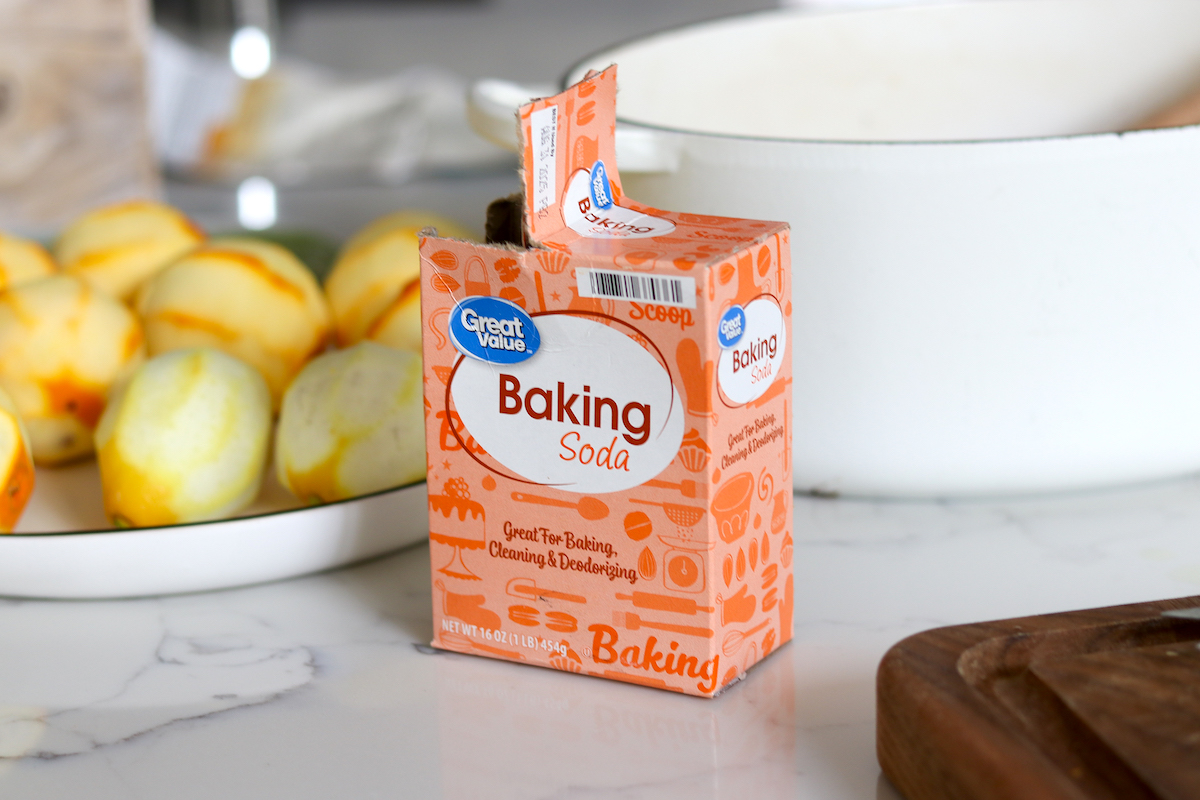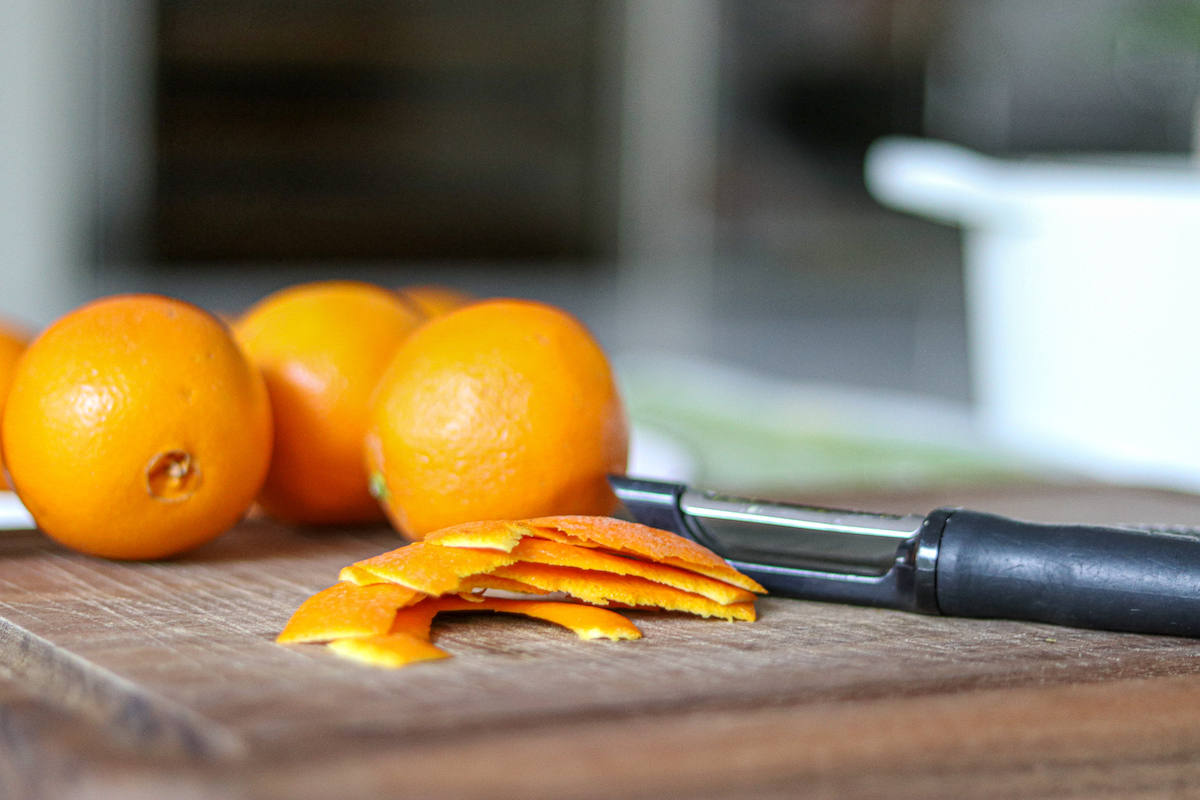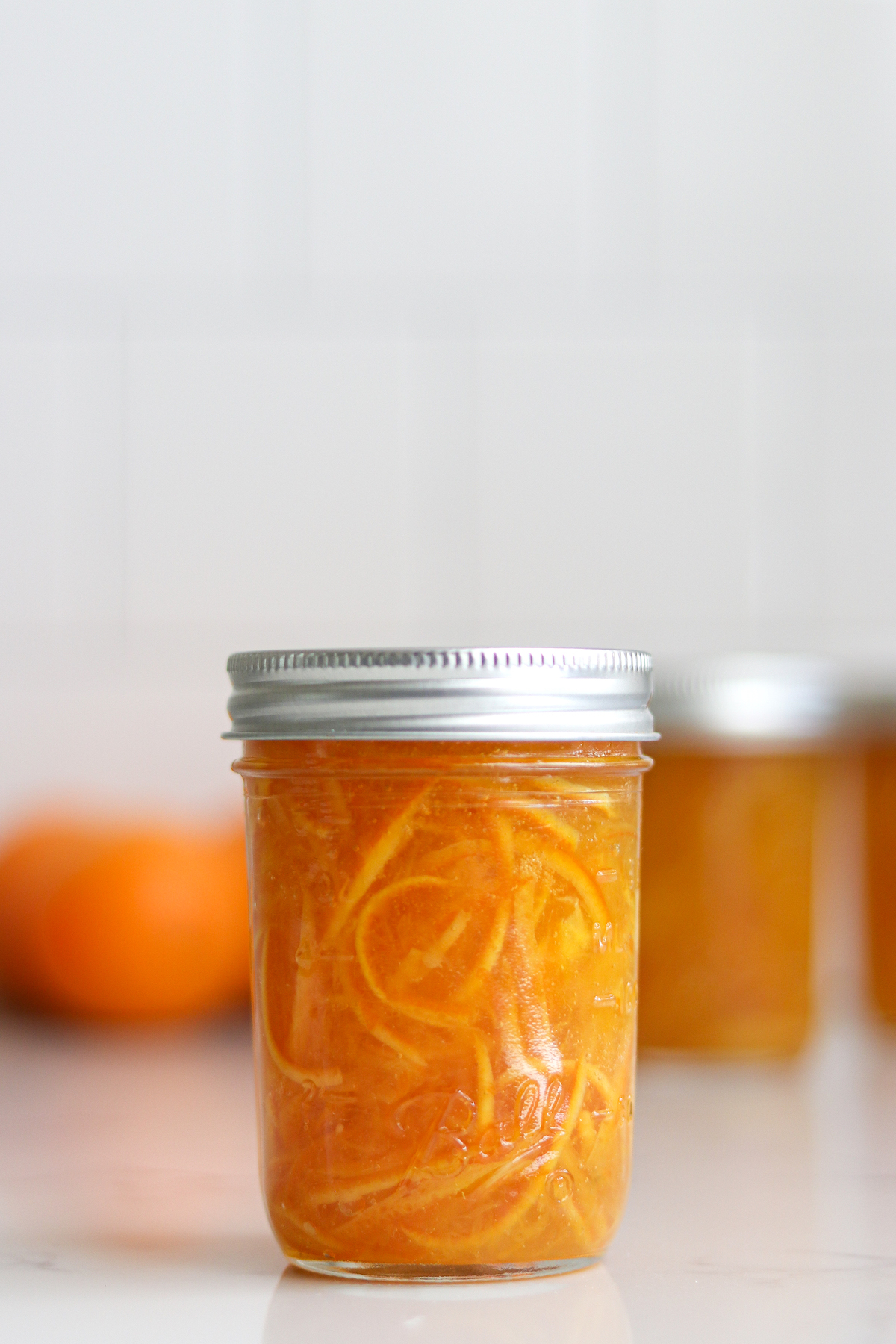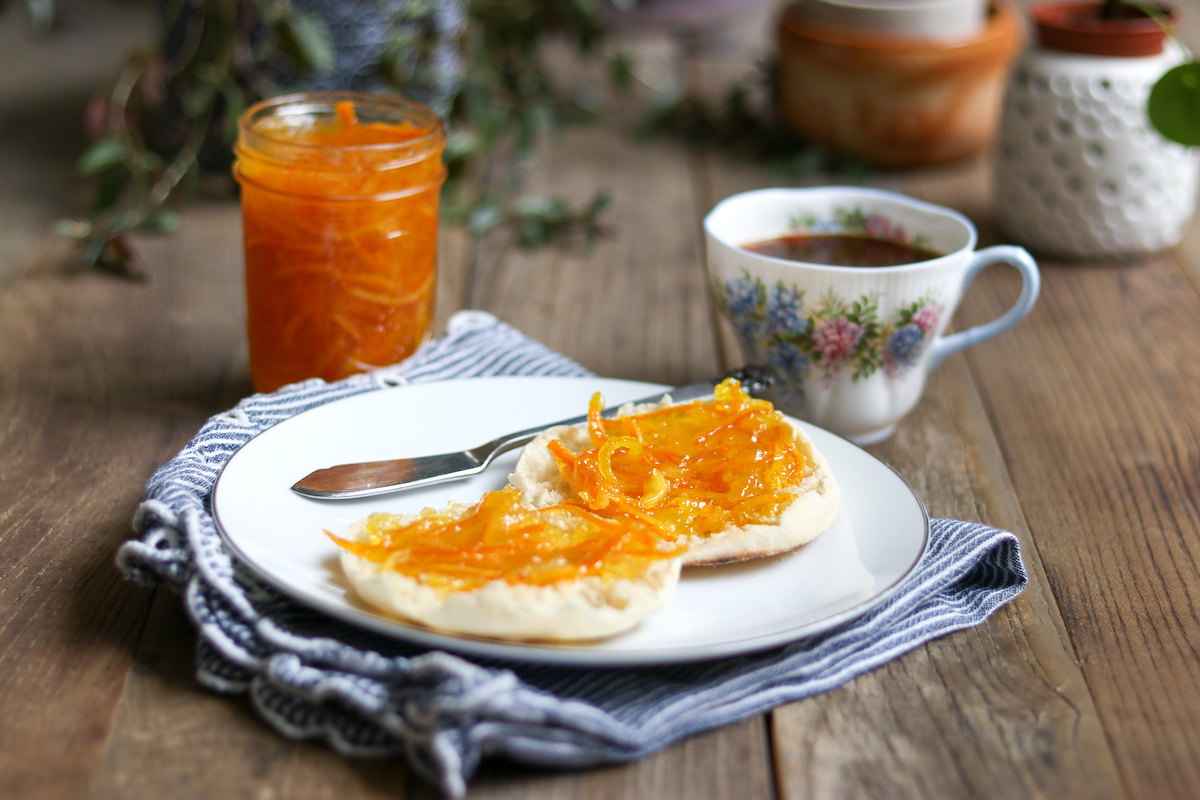This post may contain affiliate links. Please see our disclosure policy.
Low-sugar orange marmalade is a great alternative to classic orange marmalade. Most marmalade recipes include absurd amounts of sugar, but this recipe is just right by my book!

Orange marmalade recipes often call for astronomical amounts of sugar, sometimes as much as 12 cups of sugar!
To some degree, it makes sense, as originally, orange marmalade was made with bitter and sour oranges, and it was a way to use up fruit that would have been unpalatable alone.
These days, you’re more likely to make orange marmalade with grocery store oranges that are already naturally sweet, so there’s no need to put that much sugar in the batch.
The problem is, the sugar is also used to help set the jam without added pectin. This recipe uses low-sugar pectin instead, so the orange marmalade still sets, and you get just the right flavor without too much sugar.

Ingredients for Orange Marmalade
Orange marmalade uses the fruit of the orange and the outside rind, creating a rich orange flavor for this jam.
A few lemons are also added, which helps balance out the orange flavor. Trust me, you won’t taste “lemon” in this recipe, but you’ll be glad they’re there.
Using oranges alone creates a marmalade that’s a bit cloying, and you’ll appreciate the added lemons, though you won’t be able to specifically taste “lemon” in the finished product.

The recipe actually comes right off of the label inside the box of Sure Jel Low Sugar Pectin, but you can use other types of low-sugar pectin as well.
There are other pectin alternatives, such as Pomona’s Universal Pectin for low-sugar recipes. The steps for adding ingredients using other pectin brands may vary, so if you are using alternate pectin, follow the instructions in the package for the best results.
This recipe makes a relatively large batch of marmalade – 10 to 12 half-pint jars (8 oz each), so you will have plenty to share! You will need the following:
- 8 medium oranges (about 2½ to 3 pounds)
- 2 medium lemons
- 4 cups granulated sugar
- 2½ cups water
- 1 box (1.75 oz) Sure Jel Low Sugar Pectin
- 1/8 tsp. baking soda (see notes)
When selecting your oranges and lemons, you want to use fruit that is fully ripened but not so ripe that it is nearing spoilage. There should not be soft spots or bruises on the fruit.
The baking soda is added to help soften the peels of the marmalade, as normally, marmalade is cooked for hours at a time. This recipe is much quicker, so the peels need a little encouragement to soften.
Since citrus are so acidic, it also helps balance the pH. Jams have trouble setting if they’re too acidic, so a little baking soda helps cut through the acidity and bring this into the right range. Don’t worry; it’s still acidic enough for safe canning. You’re only bringing up the pH a little bit to help the pectin set.

How to Make Orange Marmalade
This recipe is for canned orange marmalade jam, and it is not a freezer jam recipe. Ensure you are familiar with hot water bath canning and have the supplies to make up to 12 half-pint jars.
If you are a beginner or are unsure of hot water bath canning, refer to my Beginner’s Guide to Water Bath Canning before proceeding.
Wash the oranges with clean water, rubbing the skins of the oranges and lemons with your hands or gently using a clean vegetable brush.
Since we use the peels of the oranges and lemons in the marmalade, I’d strongly recommend using organically grown oranges and lemons or a local producer if possible.
Using a vegetable peeler, remove just the outer orange layer of the oranges and the yellow layer of the lemons.

Oranges and lemons tend to have a thick peeling, which includes “white” peelings that can taste a little bitter. We do not want much of the white part of the rind in our marmalade.
After peeling only the outer layer off the oranges and lemons, chop the rinds you removed into fine pieces, and place the chopped rinds in a large saucepan.
You can just coarsely chop them, but the finished marmalade looks a lot better if you cut them into neat strips instead.

Add 1/8 teaspoon of baking soda to the chopped rinds, and cover with 2½ cups of water. Stir to mix and dissolve the baking soda.
The baking soda is an important ingredient as it helps to soften the rind pieces for a great texture in our finished marmalade.
Bring the mixture with the rinds, baking soda, and water to a boil over medium-high heat, stirring occasionally.

Once boiling, reduce the heat to medium-low, place a lid on the saucepan, and allow the mixture to simmer for 20 minutes, continuing to stir occasionally.
While the rind mixture is simmering, remove the rest of the white part of the peelings from the oranges and lemons, and discard.
Those white outer rinds don’t have much flavor, and they’re bitter. They go right to the compost pile. All you’re using here is the flavorful outer zest peelings, not the white pith.

Once you’ve peeled off the white pith, chop the remaining fleshy part of the fruit.
As you peel and chop the fruit, retain as much of the juice that escapes as possible.
If you can work over a shallow bowl or have a cutting board with a lip or groove around the edges, that would be perfect. Don’t juice them, just chop them and try to retain all the juice.
After the peeling mixture has simmered for 20 minutes, add the chopped fruit and all reserved juice to the saucepan.

Stir and continue to simmer for another 10 minutes, stirring occasionally.
At this point, you should have 5½ cups of cooked fruit mixture. If you have a little less, you can add a little more water. If you are short of 5½ cups, add more chopped oranges (without the peelings) and simmer again for 10 minutes.
Prepare your hot water bath canner with enough water to cover the jars by 1-2”, get your jars and 2-part canning lids ready, and other tools you may need, such as your jar lifter.
Measure 4 cups of granulated sugar into a medium bowl. Now, take ¼ cup of the sugar you have in the bowl, and pour that into a smaller bowl. Add the packet of powdered low-sugar pectin to the small bowl and stir to mix with the sugar.
Take the ¼ cup sugar and pectin mixture, and pour it into the saucepan with the fruit mixture. Stir to mix and dissolve. Place the saucepan back on the stove over high heat.
Normally, you don’t have to mix the Sure Jel Low Sugar with sugar, but since the citrus mixture is already hot, this helps prevent clumping. Mixing in a bit of sugar will distribute the pectin more evenly and allow it to dissolve properly without clumps. Don’t add all the sugar in at this point though, as if you put it all in, it can shock the pectin and prevent it from activating. Really, just mix in 1/4 cup as the recipe says.
Stirring constantly, heat the mixture until it reaches a full, rolling boil, which means that as it is boiling and you stir it, the bubbling does not stop but continues boiling despite being stirred.
Keep stirring as you slowly add the remaining sugar you premeasured into the medium bowl, dissolving the sugar.
Return the mixture to a full rolling boil and boil for exactly one minute, stirring constantly.
Remove the marmalade from heat, and skim off any foam with a metal spoon.
Immediately pour or ladle the marmalade into hot, sterilized jars.

A Canning funnel with headspace measurements will ensure you leave the correct amount of space and prevent spilling, but you can also use a headspace measure.
Be sure to adjust the headspace and leave no more than 1/4 inch, as too much headspace can prevent the jars from sealing. Even if the jars do seal, leaving too much air in the jars can result in oxidation and discolored marmalade in storage.

Using a clean, damp cloth, wipe the rim of the jars to ensure a good seal.
Place the 2-part canning lids on the jars and tighten them to “finger-tight.” Do not use a tool to screw the lid on too tightly.
Canning instructions are below.

Canning Orange Marmalade
Place your jars into a preheated canner, and then bring the canner to a hard boil. Process the jars for 10 minutes, starting the timer once the canner is boiling. Refer to the chart included with the pectin for adjusting the processing time according to your elevation.
After the processing time is complete, use a jar lifter to remove the jars from the canner and set them to cool on a towel on the counter. Leave some space between the jars to allow air to circulate, and leave them untouched for a minimum of 24 hours.
After 24 hours, check the seals. If the lids still have a “bubble” in the center of the lid, continue to let it set, or store it in the refrigerator for immediate use. If the jar does not seal after 48 hours, refrigerate the jam and use it within three weeks.
This delicious orange marmalade may take some patience to allow it to set. Even though the jars have sealed, the jam may still be runny or has a thinner consistency than you would like.
Your orange marmalade jam may take up to two weeks to set up firmly! You can still eat it before it is fully set, but you may have to wait to get the nice thickness of the marmalade.
Store sealed, unopened jars of marmalade in your pantry or a cool, dry place for up to 12 months for peak quality, and it will still be good to eat after that as long as the jars remain sealed. Refrigerate after opening, and use within three weeks.

Orange Marmalade Variations
Orange marmalade can easily be modified to add different flavors, making unique treats for your family and friends.
Flavors such as almond or vanilla go very well with orange marmalade, and all you need to do is add a small amount of pure almond or vanilla extract to the rind mixture when cooking them to soften.
Adding some finely chopped cherries, cranberries, or pomegranate to your jam mixture while cooking will make a great addition to your marmalade.
Several spices, such as ginger, rosemary, cinnamon, and cloves, also go well with oranges. Be sure to add spices in small amounts and then let it cook for a while before tasting it to see if it needs more seasoning. It can take a little heat to get the flavor of spices to pop.
And finally, there is no more fabulous treat in my mind than adding pineapple! I absolutely love pineapple-orange marmalade. Substitute 1 cup of chopped pineapple for 1 cup of chopped orange and make the rest of the recipe as listed. I love pineapple-orange marmalade on muffins or toast and sometimes on pancakes!

Ways to Use Orange Marmalade
Many prepared dishes are made even better with orange marmalade jam!
Add some orange marmalade to the pot when cooking carrots for a sweet flavor twist.
Top chicken breasts with orange marmalade for a refreshing orange-chicken flavor.
Orange marmalade makes an excellent glaze for grilled pork chops. Spread some marmalade on the pork chops for the final 1-2 minutes on the grill for a sweet treat.
Bran muffins are elevated to a new level when you add orange marmalade to the recipe, and then add even more on top when they come out of the oven. They are impossible to resist!
Get creative with your orange marmalade! Anything that could use a citrus boost would benefit from adding orange marmalade.
Low Sugar Preserves
Looking for more low-sugar preserves to fill your pantry?
- Low Sugar Flower Jellies (with any edible flower)
- Low Sugar Strawberry Jam (Pomona’s Pectin)
- Low Sugar Peach Jam (Pomona’s Pectin)

Low-Sugar Orange Marmalade
Equipment
Ingredients
- 8 medium oranges
- 2 medium lemons
- 4 cups sugar, divided
- 2½ cups water
- 1 box Powdered pectin, 1.75 oz Sure Jel Low Sugar Pectin
- 1/8 tsp. baking soda, see notes
Instructions
- Wash the oranges and lemons with clean, cool water, gently rubbing with your hands or a vegetable scrubber.
- Remove the outer colored part of the orange with a vegetable peeler. Try to cut only the very outer layer, and do not get too much of the thick, white inner peeling. Do the same with the lemons.
- Chop the orange and lemon peels into fine pieces and place in a large saucepan.
- Add 1/8 tsp. baking soda to the peelings, and cover with 2 ½ cups of water, stir to dissolve the baking soda.
- Bring the orange and lemon peel mixture to a boil, cover, and reduce the heat to medium-low.
- Simmer the mixture for 20 minutes, stirring occasionally.
- Remove the remaining white layer of peeling from the oranges and lemons, discarding the white peels until you have the remaining fleshy citrus.
- Chop the remaining citrus into small pieces, and reserve juices from the fruit while peeling and cutting.
- Add the chopped citrus and juices to the pan of cooked peels, stir to mix, and simmer for an additional 10 minutes.
- Prepare jars and a hot water bath
- Measure 4 cups of sugar into a medium bowl.
- Using ¼ cup measure, take only ¼ cup of sugar from the 4 cups you just placed in a bowl, and pour the ¼ cup of sugar into a small bowl. Add the powdered pectin to the sugar in the small bowl, and stir to mix.
- Add this sugar/pectin mix to the fruit mixture on the stove, stirring to dissolve.
- Bring the jam mixture to a full rolling boil.
- Slowly add the remaining premeasured sugar while stirring continuously. Continue to cook until the mixture returns to a full rolling boil.
- Boil the jam for exactly one full minute.
- Remove the marmalade from the stove and skim off any foam with a metal spoon if desired.
- Immediately pour or ladle the hot marmalade into prepared hot jars, leaving ¼” headspace at the top of the jars.
- Wipe the rims of the jars with a clean cloth, and apply the 2-part canning lids.
- Preserve the marmalade using a hot water bath canning method for 10 minutes (or 15 minutes if above 6,000 feet in elevation).
- After processing, allow the jars to cool and seal for 24 hours or longer. It may take up to two weeks for the marmalade to set firmly.
- Sealed marmalade will retain peak quality for up to 12 months stored in a cool, dry place or pantry. Refrigerate the marmalade once opened.
Notes
Nutrition
Nutrition information is automatically calculated, so should only be used as an approximation.
Marmalade Recipes
Love a little citrus in a jar?
Jam Recipes
Keep your canning jars full with these tasty jam recipes!





I’ve come to love freezer jams and I’m wondering if this recipe could be frozen instesd of canned.
Yup, you can make this as a freezer preserve. What I’d recommend is waiting until it fully sets before freezing. Give it about 48 to 72 hours in the fridge, which is plenty of time to get a nice firm set, and then transfer it to the freezer. That’s optional, but it should give you a slightly better finished freezer preserve. Enjoy!